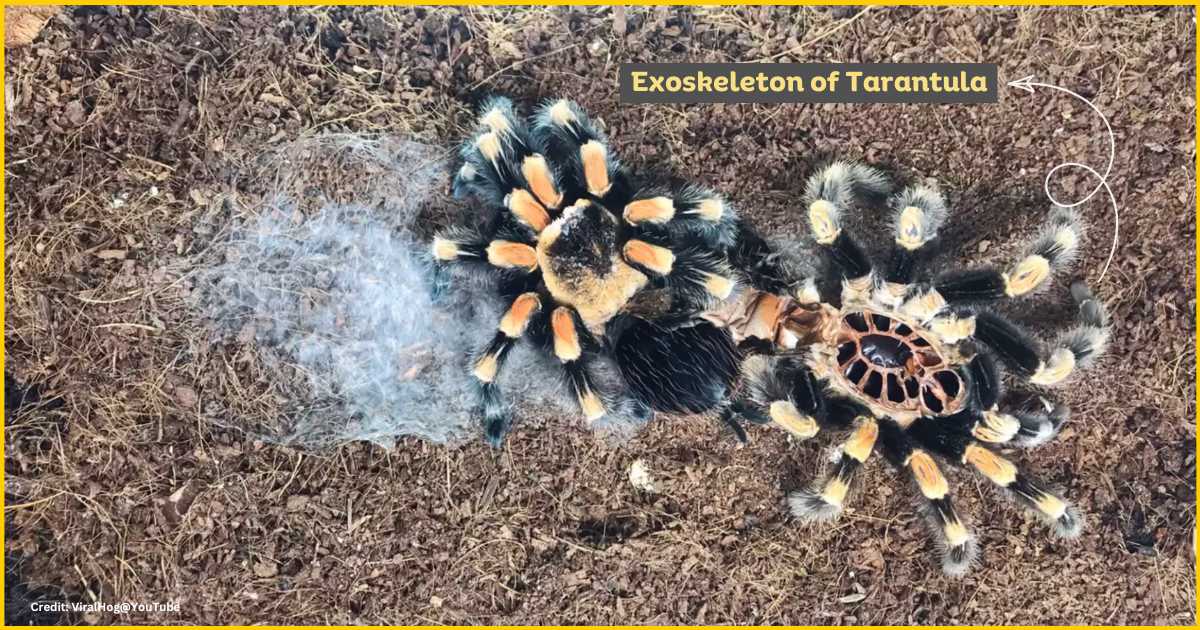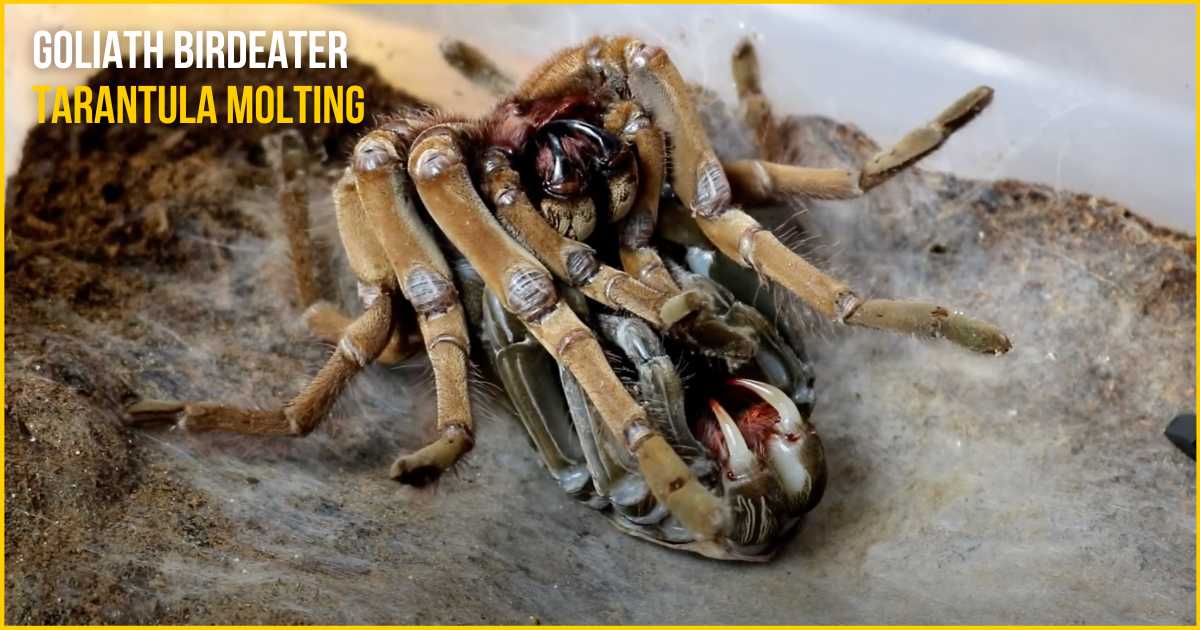Table of Contents

How often do tarantulas molt?
The age of a spider plays an important role in how often do tarantulas molt. The frequency of molting depends on the age of your tarantula and various other factors. Younger spiders molt more often, about once a month, while older ones molt less frequently, typically once a year or every two years.
What is Tarantula Molting?
Molting, also known as ecdysis, is a process of shedding exoskeleton in the life of arachnids. So, when tarantulas shed their exoskeleton, it’s crucial for their growth, development and overall well-being. And this process is called Tarantula Molting.
If you are a tarantula owner or planning to own a tarantula, it’s crucial to learn about tarantula molting. So, lets find out how often do tarantulas molt and why do they do it?

How often do tarantulas molt and why do they do it?
Tarantula molting is a vital process, and tarantulas periodically molt throughout their lives. The frequency of molting depends on various factors such as species, age, and growth rate. Younger tarantulas molt much more frequently than adults. Some species of young tarantulas molt every few weeks in their early stages of development. As they mature, molting frequency typically decreases, occurring once or twice a year.
All spiders shed their skin or exoskeleton through the molting process. The primary reason for tarantula molting is growth and regeneration. Molting allows them to shed their outer shell or exoskeleton and grow larger. This process of molting also contributes to their overall well-being. So, if you are wondering why tarantulas molt, the answer is straightforward: Tarantulas molt to grow.
While molting facilitates growth, it can also signify the end of a tarantula’s life. Most species of tarantulas take between two and five years to reach sexual maturity, although some species may take up to 10 years. When a male tarantula reaches adulthood, they typically have an 18-month lifespan and immediately begin searching for a female mate. Female tarantulas continue to molt after reaching maturity, but males rarely do so again once they reach adulthood. Those males that attempt to molt in this stage often become stuck during the process due to their sexual organs, leading to their death.
How Long Does Tarantula Molting Take?
Molting typically takes between 15 minutes to a whole day. While your tarantula is molting, it’s important to observe them but refrain from touching or handling them. You can verify molting by examining the molt left behind, which looks just like another spider.
The Signs of Tarantula Molting
As a tarantula owner, understanding the signs of tarantula molting is crucial for ensuring proper care and support during this critical period.
Darkened Exoskeleton
Prior to molting, a tarantula’s exoskeleton often darkens or becomes dull in appearance. This change in coloration indicates that the molting process is approaching.
Reduced Activity
As a tarantula prepares to molt, it may exhibit reduced activity levels. This can manifest as decreased movement and a tendency to remain hidden within its enclosure.
Loss of Appetite
One of the most noticeable signs of impending molting is a loss of appetite. Tarantulas typically stop eating in the days or weeks leading up to a molt as their metabolic activity decreases.
Webbing Behavior
Some tarantulas exhibit specific webbing behavior before molting. They may construct a thick layer of silk around their hideout or create a molting mat to provide a secure surface for the molting process.
Bald Spot on Abdomen
In certain species, a bald spot may appear on the tarantula’s abdomen before molting. This bald patch indicates the separation of the old exoskeleton from the new one forming beneath.
The Stages of Tarantula Molting
Tarantula molting occurs in several distinct stages, each with its own significance:
Pre-Molting Stage
Before molting, a tarantula will enter a pre-molt phase. During this stage, the tarantula may become less active, refuse food, and exhibit changes in behavior. Its exoskeleton will also start to darken as the new exoskeleton begins to form underneath.
Molting Stage
The molt itself is a remarkable sight to behold. The tarantula will lie on its back, legs curled upward, as it begins to shed its old exoskeleton. This process can take several hours to complete, during which the tarantula is extremely vulnerable.
Post-Molting Stage
After molting, the tarantula will emerge with a soft, pliable exoskeleton. Initially, it may appear pale and fragile, but over time, its new exoskeleton will harden and darken. During this period, the tarantula is particularly sensitive and should be handled with care.
Caring Tips for Owners of Molting Tarantulas
Taking care of a tarantula during and after molting is crucial to ensure its health and well-being. Here are some essential tips for tarantula owners to follow:
Minimize Disturbance
During the molting process, it’s essential to minimize disturbances in the tarantula’s environment. Avoid handling or disturbing the tarantula, as this can cause stress and disrupt the molting process.
Also, avoid touching or handling your tarantula immediately after molting, as their body is extremely soft and vulnerable right after shedding their exoskeleton.
Maintain Optimal Conditions
Ensure that the tarantula’s enclosure maintains optimal temperature and humidity levels. Too low humidity can lead to difficulties in molting, while excessive humidity can promote mold growth and respiratory issues.
Monitor Closely
Keep a close eye on the tarantula during the molting process, but refrain from intervening unless absolutely necessary. If you notice any signs of distress or difficulty, consult with a veterinarian or experienced tarantula keeper for guidance.
Offer Gentle Assistance if Needed
In some cases, a tarantula may struggle to shed its old exoskeleton completely. If you notice any stuck patches or difficulties, you can gently mist the tarantula with water to help soften the exoskeleton and aid in shedding.
Post-Molting Care
After molting, the tarantula will have a soft and vulnerable new exoskeleton. Avoid handling or disturbing the tarantula during this time, as its new exoskeleton needs time to harden and darken.
Resume Feeding Gradually
Firstly, do not feed your newly molted tarantula for at least a week. Once the tarantula has fully recovered from molting and its new exoskeleton has hardened, gradually resume feeding. Offer small prey items such as crickets or mealworms and monitor the tarantula’s appetite and behavior.
Conclusion
Tarantula molting is a natural and vital process in the life of these fascinating arachnids. From the pre-molting phase to the post-molting recovery, each stage is carefully coordinated to support the tarantula’s growth and development. By understanding the signs, stages, and factors influencing molting, tarantula enthusiasts can provide the optimal care and support needed for their beloved pets. Minimizing disturbances, maintaining optimal conditions, and offering gentle assistance when necessary are key aspects of ensuring a successful molting process. Through careful observation and attentive care, tarantula owners can witness the remarkable resilience and adaptability of these creatures, fostering a deep appreciation for their beauty and complexity.
